Gender Equality in Public Documents: Terms, Debate, and Analysis
VerifiedAdded on 2023/06/12
|9
|2738
|394
Essay
AI Summary
This essay explores the multifaceted dimensions of gender, focusing on its representation and interpretation within public documents. It delves into the ongoing debates surrounding gender equality, highlighting the emphasis on women's empowerment while also addressing the often-overlooked aspects of men's health. The analysis encompasses various global initiatives, such as the United Nations' Sustainable Development Goals and the World Health Organization's Healthy Life Expectancy statistics, to illustrate the current state of gender-related policies and outcomes. Furthermore, the essay examines how different public documents, including the Council of Europe's Gender Equality Glossary and the United Nations Human Development Report, apply the concept of gender and contribute to the broader discourse on equality. By scrutinizing these documents, the essay aims to provide a comprehensive understanding of the challenges and advancements in achieving gender equality worldwide, emphasizing the need for a balanced approach that considers the needs and rights of all genders. Desklib provides access to similar essays and study resources for students.
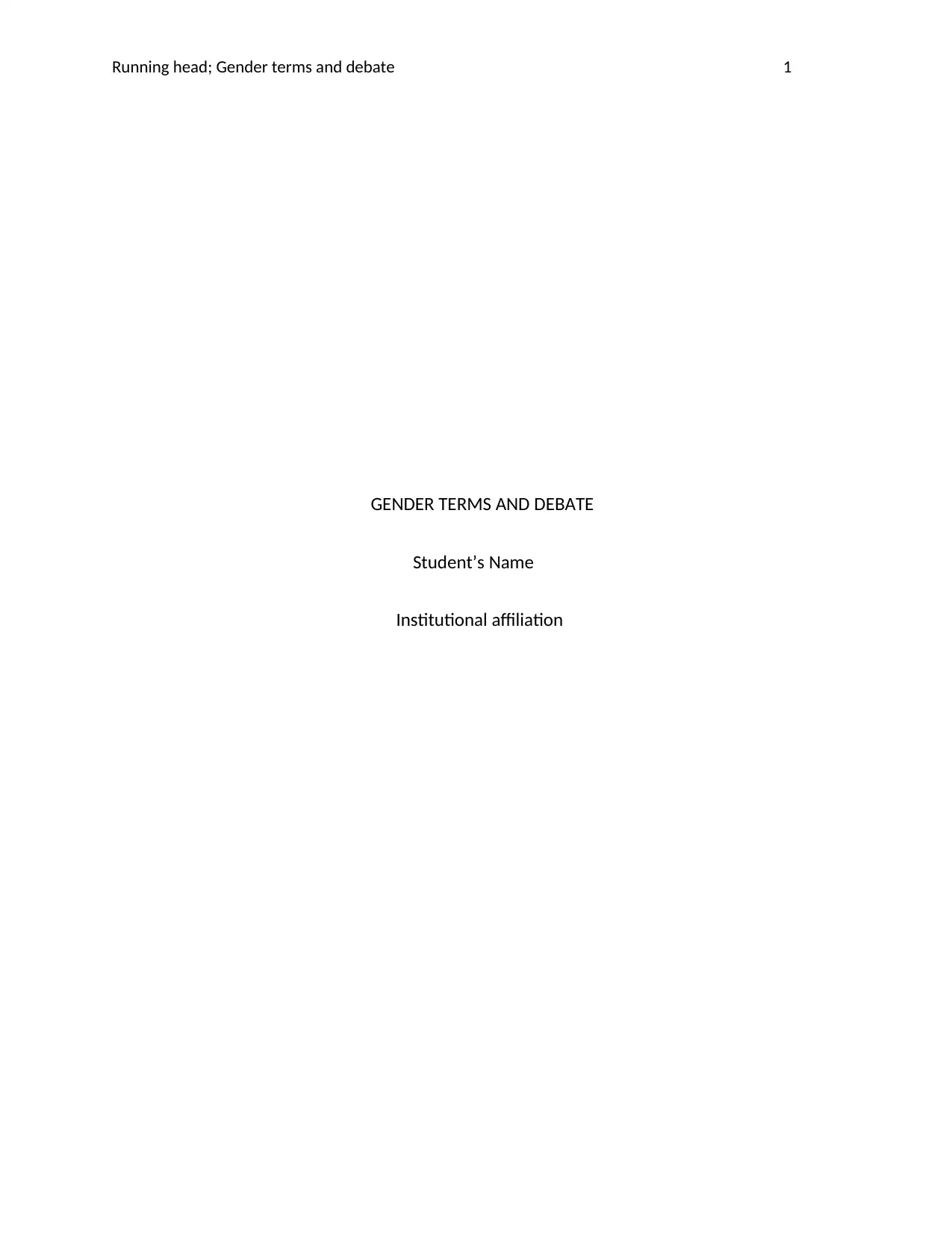
Running head; Gender terms and debate 1
GENDER TERMS AND DEBATE
Student’s Name
Institutional affiliation
GENDER TERMS AND DEBATE
Student’s Name
Institutional affiliation
Paraphrase This Document
Need a fresh take? Get an instant paraphrase of this document with our AI Paraphraser
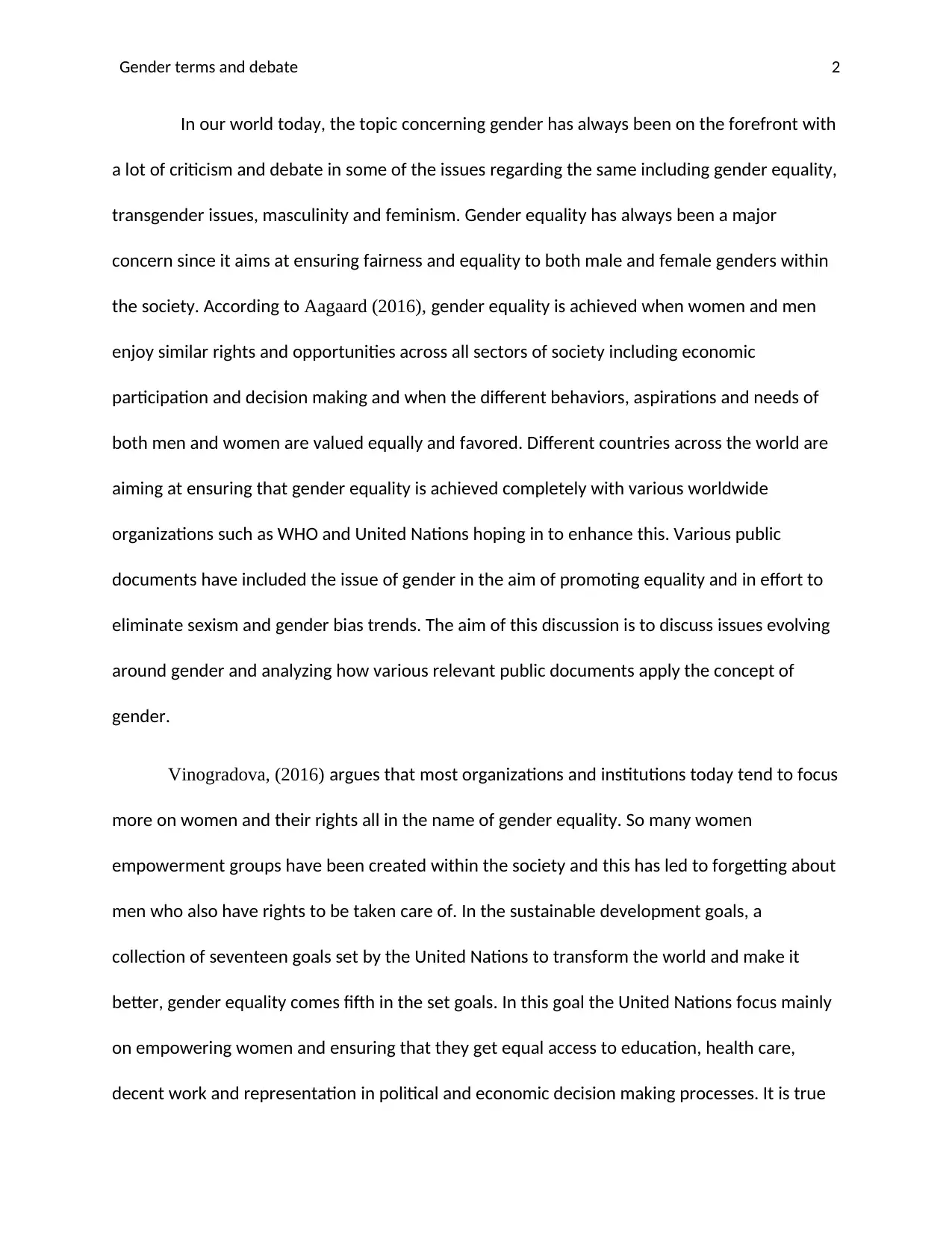
Gender terms and debate 2
In our world today, the topic concerning gender has always been on the forefront with
a lot of criticism and debate in some of the issues regarding the same including gender equality,
transgender issues, masculinity and feminism. Gender equality has always been a major
concern since it aims at ensuring fairness and equality to both male and female genders within
the society. According to Aagaard (2016), gender equality is achieved when women and men
enjoy similar rights and opportunities across all sectors of society including economic
participation and decision making and when the different behaviors, aspirations and needs of
both men and women are valued equally and favored. Different countries across the world are
aiming at ensuring that gender equality is achieved completely with various worldwide
organizations such as WHO and United Nations hoping in to enhance this. Various public
documents have included the issue of gender in the aim of promoting equality and in effort to
eliminate sexism and gender bias trends. The aim of this discussion is to discuss issues evolving
around gender and analyzing how various relevant public documents apply the concept of
gender.
Vinogradova, (2016) argues that most organizations and institutions today tend to focus
more on women and their rights all in the name of gender equality. So many women
empowerment groups have been created within the society and this has led to forgetting about
men who also have rights to be taken care of. In the sustainable development goals, a
collection of seventeen goals set by the United Nations to transform the world and make it
better, gender equality comes fifth in the set goals. In this goal the United Nations focus mainly
on empowering women and ensuring that they get equal access to education, health care,
decent work and representation in political and economic decision making processes. It is true
In our world today, the topic concerning gender has always been on the forefront with
a lot of criticism and debate in some of the issues regarding the same including gender equality,
transgender issues, masculinity and feminism. Gender equality has always been a major
concern since it aims at ensuring fairness and equality to both male and female genders within
the society. According to Aagaard (2016), gender equality is achieved when women and men
enjoy similar rights and opportunities across all sectors of society including economic
participation and decision making and when the different behaviors, aspirations and needs of
both men and women are valued equally and favored. Different countries across the world are
aiming at ensuring that gender equality is achieved completely with various worldwide
organizations such as WHO and United Nations hoping in to enhance this. Various public
documents have included the issue of gender in the aim of promoting equality and in effort to
eliminate sexism and gender bias trends. The aim of this discussion is to discuss issues evolving
around gender and analyzing how various relevant public documents apply the concept of
gender.
Vinogradova, (2016) argues that most organizations and institutions today tend to focus
more on women and their rights all in the name of gender equality. So many women
empowerment groups have been created within the society and this has led to forgetting about
men who also have rights to be taken care of. In the sustainable development goals, a
collection of seventeen goals set by the United Nations to transform the world and make it
better, gender equality comes fifth in the set goals. In this goal the United Nations focus mainly
on empowering women and ensuring that they get equal access to education, health care,
decent work and representation in political and economic decision making processes. It is true
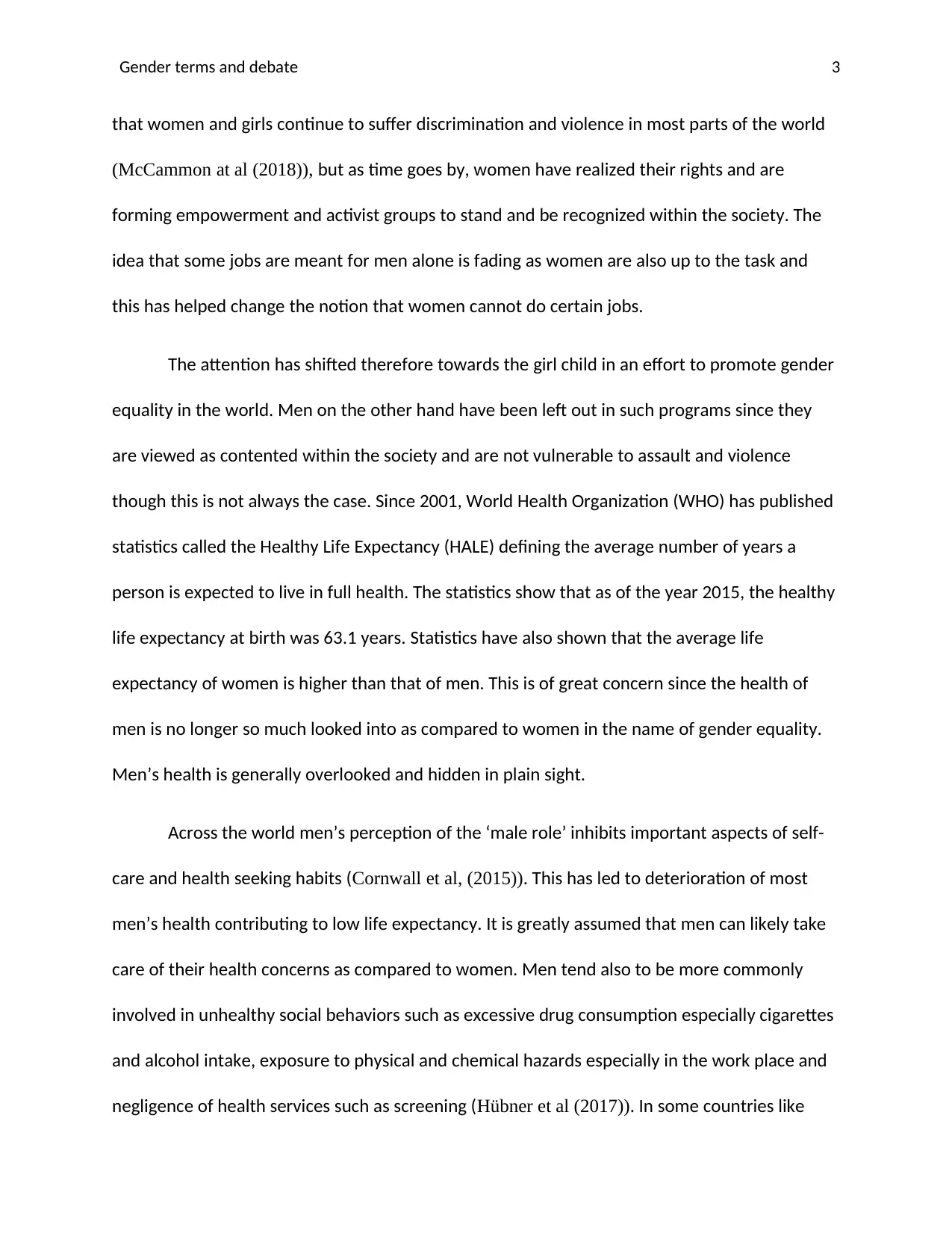
Gender terms and debate 3
that women and girls continue to suffer discrimination and violence in most parts of the world
(McCammon at al (2018)), but as time goes by, women have realized their rights and are
forming empowerment and activist groups to stand and be recognized within the society. The
idea that some jobs are meant for men alone is fading as women are also up to the task and
this has helped change the notion that women cannot do certain jobs.
The attention has shifted therefore towards the girl child in an effort to promote gender
equality in the world. Men on the other hand have been left out in such programs since they
are viewed as contented within the society and are not vulnerable to assault and violence
though this is not always the case. Since 2001, World Health Organization (WHO) has published
statistics called the Healthy Life Expectancy (HALE) defining the average number of years a
person is expected to live in full health. The statistics show that as of the year 2015, the healthy
life expectancy at birth was 63.1 years. Statistics have also shown that the average life
expectancy of women is higher than that of men. This is of great concern since the health of
men is no longer so much looked into as compared to women in the name of gender equality.
Men’s health is generally overlooked and hidden in plain sight.
Across the world men’s perception of the ‘male role’ inhibits important aspects of self-
care and health seeking habits (Cornwall et al, (2015)). This has led to deterioration of most
men’s health contributing to low life expectancy. It is greatly assumed that men can likely take
care of their health concerns as compared to women. Men tend also to be more commonly
involved in unhealthy social behaviors such as excessive drug consumption especially cigarettes
and alcohol intake, exposure to physical and chemical hazards especially in the work place and
negligence of health services such as screening (Hübner et al (2017)). In some countries like
that women and girls continue to suffer discrimination and violence in most parts of the world
(McCammon at al (2018)), but as time goes by, women have realized their rights and are
forming empowerment and activist groups to stand and be recognized within the society. The
idea that some jobs are meant for men alone is fading as women are also up to the task and
this has helped change the notion that women cannot do certain jobs.
The attention has shifted therefore towards the girl child in an effort to promote gender
equality in the world. Men on the other hand have been left out in such programs since they
are viewed as contented within the society and are not vulnerable to assault and violence
though this is not always the case. Since 2001, World Health Organization (WHO) has published
statistics called the Healthy Life Expectancy (HALE) defining the average number of years a
person is expected to live in full health. The statistics show that as of the year 2015, the healthy
life expectancy at birth was 63.1 years. Statistics have also shown that the average life
expectancy of women is higher than that of men. This is of great concern since the health of
men is no longer so much looked into as compared to women in the name of gender equality.
Men’s health is generally overlooked and hidden in plain sight.
Across the world men’s perception of the ‘male role’ inhibits important aspects of self-
care and health seeking habits (Cornwall et al, (2015)). This has led to deterioration of most
men’s health contributing to low life expectancy. It is greatly assumed that men can likely take
care of their health concerns as compared to women. Men tend also to be more commonly
involved in unhealthy social behaviors such as excessive drug consumption especially cigarettes
and alcohol intake, exposure to physical and chemical hazards especially in the work place and
negligence of health services such as screening (Hübner et al (2017)). In some countries like
⊘ This is a preview!⊘
Do you want full access?
Subscribe today to unlock all pages.

Trusted by 1+ million students worldwide
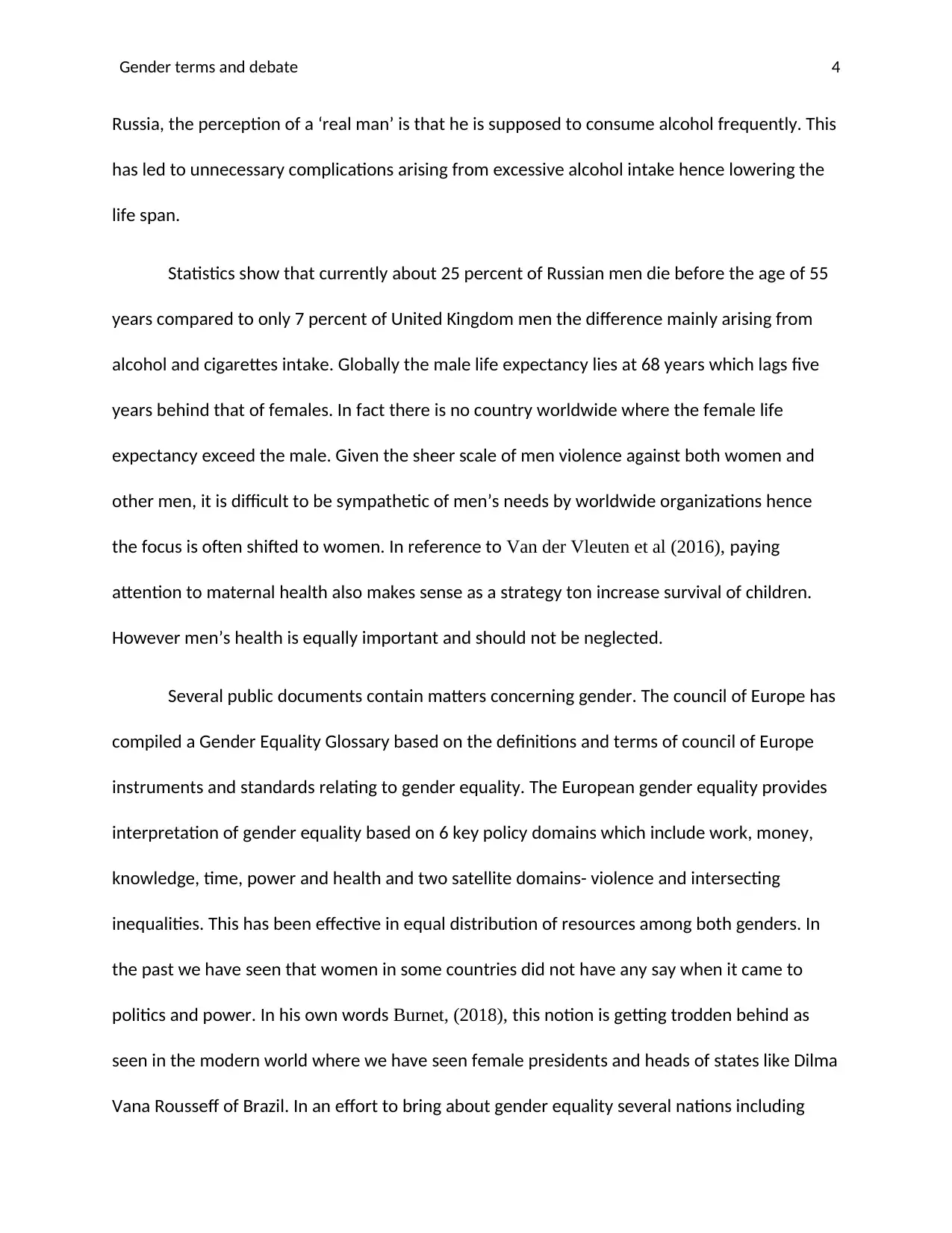
Gender terms and debate 4
Russia, the perception of a ‘real man’ is that he is supposed to consume alcohol frequently. This
has led to unnecessary complications arising from excessive alcohol intake hence lowering the
life span.
Statistics show that currently about 25 percent of Russian men die before the age of 55
years compared to only 7 percent of United Kingdom men the difference mainly arising from
alcohol and cigarettes intake. Globally the male life expectancy lies at 68 years which lags five
years behind that of females. In fact there is no country worldwide where the female life
expectancy exceed the male. Given the sheer scale of men violence against both women and
other men, it is difficult to be sympathetic of men’s needs by worldwide organizations hence
the focus is often shifted to women. In reference to Van der Vleuten et al (2016), paying
attention to maternal health also makes sense as a strategy ton increase survival of children.
However men’s health is equally important and should not be neglected.
Several public documents contain matters concerning gender. The council of Europe has
compiled a Gender Equality Glossary based on the definitions and terms of council of Europe
instruments and standards relating to gender equality. The European gender equality provides
interpretation of gender equality based on 6 key policy domains which include work, money,
knowledge, time, power and health and two satellite domains- violence and intersecting
inequalities. This has been effective in equal distribution of resources among both genders. In
the past we have seen that women in some countries did not have any say when it came to
politics and power. In his own words Burnet, (2018), this notion is getting trodden behind as
seen in the modern world where we have seen female presidents and heads of states like Dilma
Vana Rousseff of Brazil. In an effort to bring about gender equality several nations including
Russia, the perception of a ‘real man’ is that he is supposed to consume alcohol frequently. This
has led to unnecessary complications arising from excessive alcohol intake hence lowering the
life span.
Statistics show that currently about 25 percent of Russian men die before the age of 55
years compared to only 7 percent of United Kingdom men the difference mainly arising from
alcohol and cigarettes intake. Globally the male life expectancy lies at 68 years which lags five
years behind that of females. In fact there is no country worldwide where the female life
expectancy exceed the male. Given the sheer scale of men violence against both women and
other men, it is difficult to be sympathetic of men’s needs by worldwide organizations hence
the focus is often shifted to women. In reference to Van der Vleuten et al (2016), paying
attention to maternal health also makes sense as a strategy ton increase survival of children.
However men’s health is equally important and should not be neglected.
Several public documents contain matters concerning gender. The council of Europe has
compiled a Gender Equality Glossary based on the definitions and terms of council of Europe
instruments and standards relating to gender equality. The European gender equality provides
interpretation of gender equality based on 6 key policy domains which include work, money,
knowledge, time, power and health and two satellite domains- violence and intersecting
inequalities. This has been effective in equal distribution of resources among both genders. In
the past we have seen that women in some countries did not have any say when it came to
politics and power. In his own words Burnet, (2018), this notion is getting trodden behind as
seen in the modern world where we have seen female presidents and heads of states like Dilma
Vana Rousseff of Brazil. In an effort to bring about gender equality several nations including
Paraphrase This Document
Need a fresh take? Get an instant paraphrase of this document with our AI Paraphraser
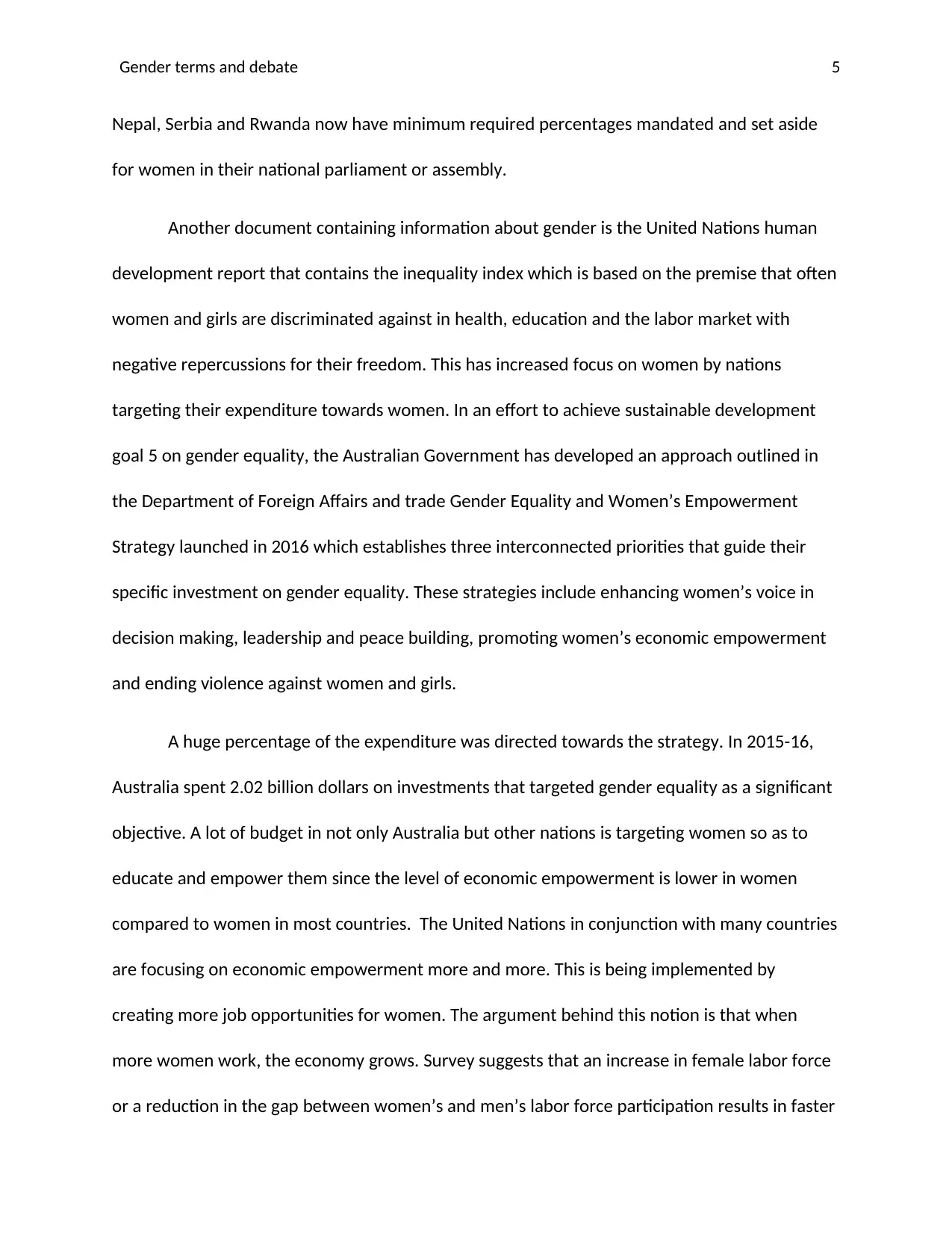
Gender terms and debate 5
Nepal, Serbia and Rwanda now have minimum required percentages mandated and set aside
for women in their national parliament or assembly.
Another document containing information about gender is the United Nations human
development report that contains the inequality index which is based on the premise that often
women and girls are discriminated against in health, education and the labor market with
negative repercussions for their freedom. This has increased focus on women by nations
targeting their expenditure towards women. In an effort to achieve sustainable development
goal 5 on gender equality, the Australian Government has developed an approach outlined in
the Department of Foreign Affairs and trade Gender Equality and Women’s Empowerment
Strategy launched in 2016 which establishes three interconnected priorities that guide their
specific investment on gender equality. These strategies include enhancing women’s voice in
decision making, leadership and peace building, promoting women’s economic empowerment
and ending violence against women and girls.
A huge percentage of the expenditure was directed towards the strategy. In 2015-16,
Australia spent 2.02 billion dollars on investments that targeted gender equality as a significant
objective. A lot of budget in not only Australia but other nations is targeting women so as to
educate and empower them since the level of economic empowerment is lower in women
compared to women in most countries. The United Nations in conjunction with many countries
are focusing on economic empowerment more and more. This is being implemented by
creating more job opportunities for women. The argument behind this notion is that when
more women work, the economy grows. Survey suggests that an increase in female labor force
or a reduction in the gap between women’s and men’s labor force participation results in faster
Nepal, Serbia and Rwanda now have minimum required percentages mandated and set aside
for women in their national parliament or assembly.
Another document containing information about gender is the United Nations human
development report that contains the inequality index which is based on the premise that often
women and girls are discriminated against in health, education and the labor market with
negative repercussions for their freedom. This has increased focus on women by nations
targeting their expenditure towards women. In an effort to achieve sustainable development
goal 5 on gender equality, the Australian Government has developed an approach outlined in
the Department of Foreign Affairs and trade Gender Equality and Women’s Empowerment
Strategy launched in 2016 which establishes three interconnected priorities that guide their
specific investment on gender equality. These strategies include enhancing women’s voice in
decision making, leadership and peace building, promoting women’s economic empowerment
and ending violence against women and girls.
A huge percentage of the expenditure was directed towards the strategy. In 2015-16,
Australia spent 2.02 billion dollars on investments that targeted gender equality as a significant
objective. A lot of budget in not only Australia but other nations is targeting women so as to
educate and empower them since the level of economic empowerment is lower in women
compared to women in most countries. The United Nations in conjunction with many countries
are focusing on economic empowerment more and more. This is being implemented by
creating more job opportunities for women. The argument behind this notion is that when
more women work, the economy grows. Survey suggests that an increase in female labor force
or a reduction in the gap between women’s and men’s labor force participation results in faster

Gender terms and debate 6
economic growth (Pettersson, et al (2017). Evidence from a range of countries has shown that
increasing the share of household income controlled by women, either through own earnings
or cash transfers changes spending in a way that benefit children.
According to Stoet et al (2018), an increase in women and girl’s education has also
proven to contribute to higher economic growth. This has also significantly led to a decrease in
child mortality rate. A study using data from 219 countries from 1970 to 2009 found that for
every one additional year of education for women of reproductive age, child mortality
decreased by 9.5 per cent. Fleming et al (2015) explains that the view of women as economic
dependents is also fading since more women are engaging in the corporate world of work.
Although statistics still show that there are more men working or employed as compared to
women, it is correct to say that the gap is getting closed slowly as gender equality is taking
shape worldwide (Flood et al (2017). In 2013, the male employment to population ratio stood
at 72.2 percent, while the ratio for females was 47.1 per cent. This has constantly improved
over the years due to the various initiatives that have been taken to bring about gender
equality.
Globally, most women are still paid less than men. Women in most countries earn on
average only 60 to 75 per cent of men’s wages. Contributing factors include the fact that
women are more likely to engage in low productivity activities and to work in the informal
sector with less mobility to the formal sector than men (Broman, (2017). In an effort to balance
gender issues, some work places have begun to balance the ratio to avoid bias trends. In a
situation whereby both a man and a woman are qualified for a particular job, the employer can
consider numbers of male and female staff and employ either in an effort to balance the
economic growth (Pettersson, et al (2017). Evidence from a range of countries has shown that
increasing the share of household income controlled by women, either through own earnings
or cash transfers changes spending in a way that benefit children.
According to Stoet et al (2018), an increase in women and girl’s education has also
proven to contribute to higher economic growth. This has also significantly led to a decrease in
child mortality rate. A study using data from 219 countries from 1970 to 2009 found that for
every one additional year of education for women of reproductive age, child mortality
decreased by 9.5 per cent. Fleming et al (2015) explains that the view of women as economic
dependents is also fading since more women are engaging in the corporate world of work.
Although statistics still show that there are more men working or employed as compared to
women, it is correct to say that the gap is getting closed slowly as gender equality is taking
shape worldwide (Flood et al (2017). In 2013, the male employment to population ratio stood
at 72.2 percent, while the ratio for females was 47.1 per cent. This has constantly improved
over the years due to the various initiatives that have been taken to bring about gender
equality.
Globally, most women are still paid less than men. Women in most countries earn on
average only 60 to 75 per cent of men’s wages. Contributing factors include the fact that
women are more likely to engage in low productivity activities and to work in the informal
sector with less mobility to the formal sector than men (Broman, (2017). In an effort to balance
gender issues, some work places have begun to balance the ratio to avoid bias trends. In a
situation whereby both a man and a woman are qualified for a particular job, the employer can
consider numbers of male and female staff and employ either in an effort to balance the
⊘ This is a preview!⊘
Do you want full access?
Subscribe today to unlock all pages.

Trusted by 1+ million students worldwide

Gender terms and debate 7
gender. Even though gender inequality issues are still large in some parts of the world a huge
effort is being put into place to eliminate such trends. Senior positions no longer belong to men
alone at work places since women have an equal chance of delivering (Roberts, A. (2015). The
notion of having a weaker sex has been passed by time and sexism is being eradicated by
civilization.
Worldwide competitions are also engaging both genders to participate in such
competitions with an equal chance. For example, games that had in the past been considered
masculine such as football, wrestling and boxing have been creating different categories for
both men and women. This has ensured that there has been equality within all fields that men
participate in. According to Kabeer, (2016), the issue of transgender has been on the lime light
and is facing a lot of criticism since people are opting to change their gender for the other with
the notion that one gender has more priorities than the other. However it is true that everyone
has freedom to make their own decisions. It is also true that someone does not decide to be
born male or female hence it is beyond human reach.
In conclusion, both men and women have a right to have equal opportunities no matter
the circumstances in place. The society and the world as a whole has still a huge task in
ensuring that gender equality is achieved. The efforts by various organizations to achieve this
equality is quite commendable. Even though the focus has been shifted towards women to
achieve this equality in various countries, we should not as well forget men especially in
matters of health so as to ensure the world becomes better for all.
gender. Even though gender inequality issues are still large in some parts of the world a huge
effort is being put into place to eliminate such trends. Senior positions no longer belong to men
alone at work places since women have an equal chance of delivering (Roberts, A. (2015). The
notion of having a weaker sex has been passed by time and sexism is being eradicated by
civilization.
Worldwide competitions are also engaging both genders to participate in such
competitions with an equal chance. For example, games that had in the past been considered
masculine such as football, wrestling and boxing have been creating different categories for
both men and women. This has ensured that there has been equality within all fields that men
participate in. According to Kabeer, (2016), the issue of transgender has been on the lime light
and is facing a lot of criticism since people are opting to change their gender for the other with
the notion that one gender has more priorities than the other. However it is true that everyone
has freedom to make their own decisions. It is also true that someone does not decide to be
born male or female hence it is beyond human reach.
In conclusion, both men and women have a right to have equal opportunities no matter
the circumstances in place. The society and the world as a whole has still a huge task in
ensuring that gender equality is achieved. The efforts by various organizations to achieve this
equality is quite commendable. Even though the focus has been shifted towards women to
achieve this equality in various countries, we should not as well forget men especially in
matters of health so as to ensure the world becomes better for all.
Paraphrase This Document
Need a fresh take? Get an instant paraphrase of this document with our AI Paraphraser

Gender terms and debate 8
REFERENCES
Aagaard, K. (2016). New and persistent gender equality challenges in academia. Scandinavian
Journal of Public Administration, 20(1), 87-90.
Broman, I. T. (2017). Early childhood education, gender relations and equality among parents
and families in Sweden. In Nordic Dialogues on Children and Families (pp. 75-90).
Routledge.
Burnet, J. E., & Kanakuze, J. D. A. (2018). Political Settlements, Women's Representation and
Gender Equality: The 2008 Gender-Based Violence Law and Gender Parity in Primary
and Secondary Education in Rwanda.
Cornwall, A., & Rivas, A. M. (2015). From ‘gender equality and ‘women’s empowerment’to
global justice: reclaiming a transformative agenda for gender and development. Third
World Quarterly, 36(2), 396-415.
Equality, G., Hearne, B. N., & McCammon, H. J. (2018). Black Women Cause Lawyers. 100
Years of the Nineteenth Amendment: An Appraisal of Women's Political Activism, 257.
Fleming, P. J., McCleary-Sills, J., Morton, M., Levtov, R., Heilman, B., & Barker, G. (2015).
Risk factors for men’s lifetime perpetration of physical violence against intimate
partners: results from the international men and gender equality survey (IMAGES) in
eight countries. PLoS One, 10(3), e0118639.
Flood, M., Russell, G., & O'Leary, J. (2017). Men make a difference: engaging men on gender
equality.
Hübner, N., Wille, E., Cambria, J., Oschatz, K., Nagengast, B., & Trautwein, U. (2017).
Maximizing gender equality by minimizing course choice options? Effects of obligatory
REFERENCES
Aagaard, K. (2016). New and persistent gender equality challenges in academia. Scandinavian
Journal of Public Administration, 20(1), 87-90.
Broman, I. T. (2017). Early childhood education, gender relations and equality among parents
and families in Sweden. In Nordic Dialogues on Children and Families (pp. 75-90).
Routledge.
Burnet, J. E., & Kanakuze, J. D. A. (2018). Political Settlements, Women's Representation and
Gender Equality: The 2008 Gender-Based Violence Law and Gender Parity in Primary
and Secondary Education in Rwanda.
Cornwall, A., & Rivas, A. M. (2015). From ‘gender equality and ‘women’s empowerment’to
global justice: reclaiming a transformative agenda for gender and development. Third
World Quarterly, 36(2), 396-415.
Equality, G., Hearne, B. N., & McCammon, H. J. (2018). Black Women Cause Lawyers. 100
Years of the Nineteenth Amendment: An Appraisal of Women's Political Activism, 257.
Fleming, P. J., McCleary-Sills, J., Morton, M., Levtov, R., Heilman, B., & Barker, G. (2015).
Risk factors for men’s lifetime perpetration of physical violence against intimate
partners: results from the international men and gender equality survey (IMAGES) in
eight countries. PLoS One, 10(3), e0118639.
Flood, M., Russell, G., & O'Leary, J. (2017). Men make a difference: engaging men on gender
equality.
Hübner, N., Wille, E., Cambria, J., Oschatz, K., Nagengast, B., & Trautwein, U. (2017).
Maximizing gender equality by minimizing course choice options? Effects of obligatory

Gender terms and debate 9
coursework in math on gender differences in STEM. Journal of Educational Psychology,
109(7), 993.
Kabeer, N. (2016). Gender equality, economic growth, and women’s agency: the “endless
variety” and “monotonous similarity” of patriarchal constraints. Feminist Economics,
22(1), 295-321.
Pettersson, K., Ahl, H., Berglund, K., & Tillmar, M. (2017). Policy actors seeking to stimulate
entrepreneurship sometimes give special attention to women. It is not given, however,
that policy initiatives for women entrepreneurs necessarily contribute to gender equality,
to social change for women–such as enhancing entrepreneurship as a means to women’s
well-being and financial or other independence–or to gendered change of society. We
claim that the outcomes... Scandinavian Journal of Management, 33(1), 50-63.
Roberts, A. (2015). The Political Economy of “Transnational Business Feminism”
PROBLEMATIZING THE CORPORATE-LED GENDER EQUALITY AGENDA.
International Feminist Journal of Politics, 17(2), 209-231.
Stoet, G., & Geary, D. C. (2018). The gender-equality paradox in science, technology,
engineering, and mathematics education. Psychological science, 0956797617741719.
Van der Vleuten, A. (2016). The price of gender equality: Member states and governance in the
European Union. Routledge.
Vinogradova, O. (2016). Plans and initiatives in selected research institutions aiming to stimulate
gender equality and enact structural change.
coursework in math on gender differences in STEM. Journal of Educational Psychology,
109(7), 993.
Kabeer, N. (2016). Gender equality, economic growth, and women’s agency: the “endless
variety” and “monotonous similarity” of patriarchal constraints. Feminist Economics,
22(1), 295-321.
Pettersson, K., Ahl, H., Berglund, K., & Tillmar, M. (2017). Policy actors seeking to stimulate
entrepreneurship sometimes give special attention to women. It is not given, however,
that policy initiatives for women entrepreneurs necessarily contribute to gender equality,
to social change for women–such as enhancing entrepreneurship as a means to women’s
well-being and financial or other independence–or to gendered change of society. We
claim that the outcomes... Scandinavian Journal of Management, 33(1), 50-63.
Roberts, A. (2015). The Political Economy of “Transnational Business Feminism”
PROBLEMATIZING THE CORPORATE-LED GENDER EQUALITY AGENDA.
International Feminist Journal of Politics, 17(2), 209-231.
Stoet, G., & Geary, D. C. (2018). The gender-equality paradox in science, technology,
engineering, and mathematics education. Psychological science, 0956797617741719.
Van der Vleuten, A. (2016). The price of gender equality: Member states and governance in the
European Union. Routledge.
Vinogradova, O. (2016). Plans and initiatives in selected research institutions aiming to stimulate
gender equality and enact structural change.
⊘ This is a preview!⊘
Do you want full access?
Subscribe today to unlock all pages.

Trusted by 1+ million students worldwide
1 out of 9
Related Documents
Your All-in-One AI-Powered Toolkit for Academic Success.
+13062052269
info@desklib.com
Available 24*7 on WhatsApp / Email
![[object Object]](/_next/static/media/star-bottom.7253800d.svg)
Unlock your academic potential
Copyright © 2020–2025 A2Z Services. All Rights Reserved. Developed and managed by ZUCOL.




